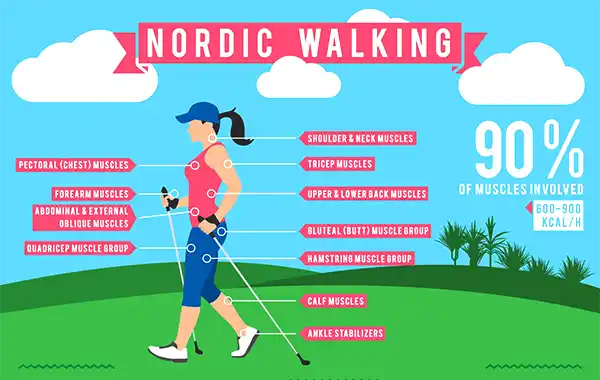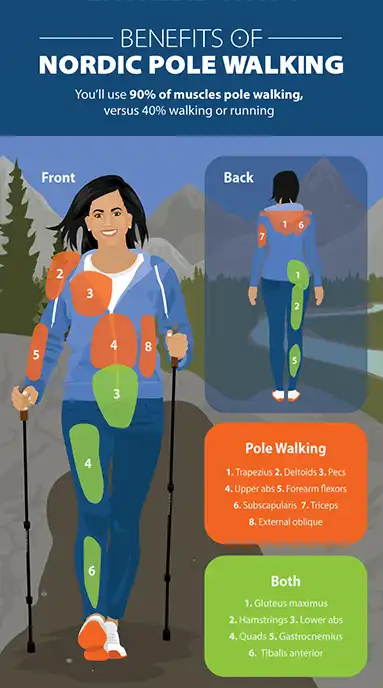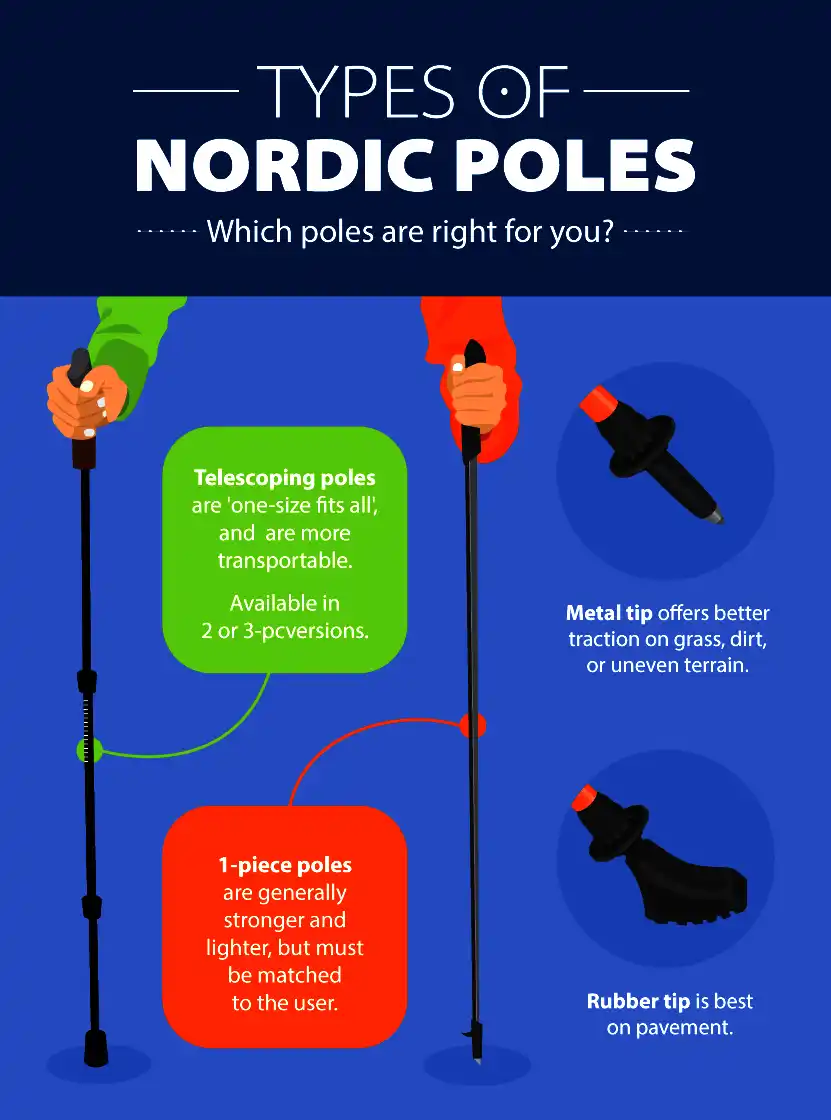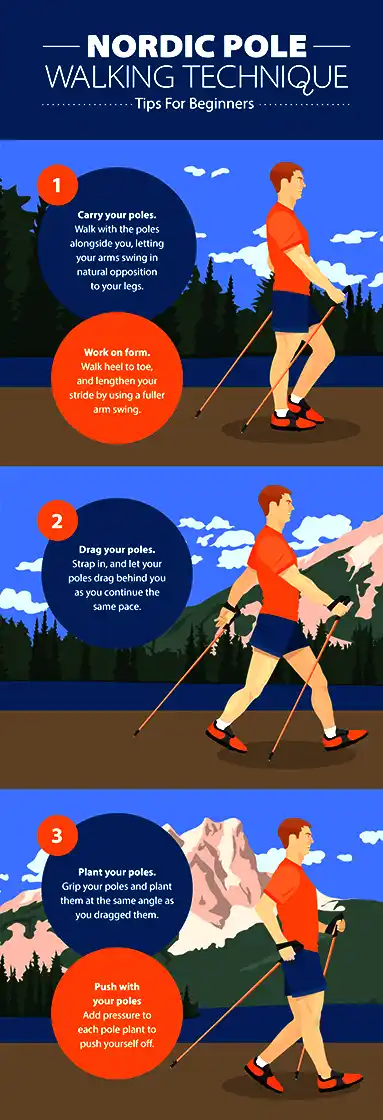
Explore the Nordic walking trend that’s sweeping the fitness world. Discover how Nordic walking can enhance your health, boost your fitness levels, and invigorate your daily routine.
Introduction
In the world of fitness, trends come and go, but some manage to stand the test of time due to their remarkable benefits. One such trend that has been gaining popularity is Nordic Walking.
In the ever-evolving landscape of fitness trends, one activity that has maintained its popularity and relevance is Nordic walking. Originating from Finland in the 1930s, Nordic walking has steadily gained momentum worldwide due to its unique blend of simplicity, effectiveness, and accessibility. This activity involves walking with specially designed poles, akin to ski poles, and has become a staple in the fitness routines of individuals seeking a low-impact yet high-intensity workout.
The core concept behind Nordic walking is simple: by adding poles to your walking routine, you engage more muscle groups and increase the overall intensity of the exercise. This results in a higher calorie burn compared to regular walking, making it an attractive option for those aiming to manage their weight or enhance their cardiovascular health.
Additionally, the poles provide stability and support, making it a suitable choice for people of various fitness levels, including those recovering from injuries or seniors looking to stay active.
You also might like: Walking Barefoot. The Most Beneficial Massage You Can Get For Free
Fitness Trend: Nordic Walking
What is Nordic Walking?
Nordic Walking is a full-body cardiovascular workout that involves walking with specially designed poles. The activity engages multiple muscle groups, providing a low-impact but highly effective exercise.
Benefits of Nordic Walking
Nordic walking isn’t just your ordinary stroll in the park; it’s a whole-body workout with a multitude of benefits. Here are some of the advantages:
- Enhanced Cardiovascular Health: Nordic walking elevates your heart rate, improving cardiovascular health and endurance.
- Increased Caloric Burn: The use of poles engages your upper body, leading to more calories burned compared to regular walking.
- Low-Impact Exercise: Nordic walking is gentle on joints, making it suitable for people of all fitness levels and ages.
- Improved Posture and Balance: The poles encourage an upright posture, aiding in spinal alignment and better balance.
- Toned Muscles: The activity engages your arms, shoulders, core, and legs, resulting in toned muscles throughout your body.
- Boosted Mood: Being outdoors and engaging in physical activity releases endorphins, promoting a positive mood.
- Social Interaction: Nordic walking groups offer a great opportunity to connect with like-minded individuals and foster a sense of community.


Techniques and Gear
Mastering the techniques of Nordic walking is crucial for reaping its full benefits. Here’s a step-by-step guide to get you started:
- Proper Pole Length: Adjust the poles to a length that allows your elbows to be at a 90-degree angle when holding them.
- Grip and Strap: Hold the grips lightly, allowing your fingers to wrap around them naturally. Secure the straps around your wrists for added stability.
- Stride: Take a natural stride, allowing your arms to swing naturally as you walk.
- Planting the Poles: Plant the poles diagonally behind you with each step, pushing off the ground.
- Engage Core Muscles: Keep your core muscles engaged and maintain an upright posture.
- Breathing: Breathe rhythmically, inhaling through your nose and exhaling through your mouth.
Types of Nordic Poles:

Simple Nordic Poles Technique:

You might like: Nordic Exercises: Embrace the Power of Scandinavian Fitness
Incorporating Nordic Walking into Your Routine
Adding Nordic walking to your fitness routine is simple and customizable. Whether you’re a beginner or an experienced fitness enthusiast, the adaptability of this trend makes it accessible for all. You can:
- Start Slow: Begin with shorter walks and gradually increase the duration and intensity as your fitness improves.
- Explore Nature: Nordic walking is an excellent way to explore parks, trails, and natural landscapes while staying active.
- Join a Group: Many communities have Nordic walking groups that offer camaraderie and motivation.
- Cross-Train: Combine Nordic walking with other exercises to create a well-rounded fitness routine.
Related: The Nordic Diet. Insane Benefits or Typical Scam?
One of the reasons Nordic walking has sustained its popularity is its adaptability. It can be tailored to meet the needs of different individuals, from casual walkers to avid fitness enthusiasts.
For beginners, it offers an approachable entry point into the world of exercise, while experienced athletes can incorporate it into their cross-training routines for a well-rounded fitness regimen. Moreover, the social aspect of Nordic walking cannot be overlooked. Group Nordic walking sessions have sprung up in parks, trails, and fitness centers, fostering a sense of community and motivation among participants.
The trend also owes its durability to the health benefits it offers. Nordic walking engages nearly 90% of the body’s muscles, including those in the upper body, core, and legs. This comprehensive muscle engagement not only improves strength and endurance but also promotes a balanced posture and reduces the strain on joints. For individuals seeking a low-impact workout that still yields impressive results, Nordic walking fits the bill perfectly.
As fitness trends come and go, Nordic walking remains a steadfast option for those looking to stay active, healthy, and engaged. Its adaptable nature, coupled with the numerous physical and social benefits it provides, ensures that this trend continues to capture the attention of people of all ages and fitness levels. Whether you’re seeking an invigorating outdoor activity or a way to enhance your overall fitness routine, Nordic walking stands as a testament to the enduring power of simple yet effective exercise concepts.
You might like: Embrace All The Changes. How To Look Beautiful At 60+
FAQs about Nordic Walking
Can anyone do Nordic walking?
Absolutely! Nordic walking is suitable for people of all ages and fitness levels. It’s a low-impact exercise that can be tailored to your individual needs.
Do I need special equipment for Nordic walking?
Yes, you’ll need Nordic walking poles that are designed to enhance your walking experience. Make sure to choose poles that are the right length for your height.
Is Nordic walking better than regular walking for fitness?
Nordic walking offers additional benefits compared to regular walking. The use of poles engages your upper body, leading to increased calorie burn and muscle engagement.
Can Nordic walking help with weight loss?
Yes, Nordic walking can contribute to weight loss when combined with a balanced diet and regular exercise. Its ability to burn more calories than traditional walking can aid in achieving weight loss goals.
Is it necessary to take lessons before starting Nordic walking?
While not mandatory, taking lessons from a certified Nordic walking instructor can help you learn proper techniques and maximize the benefits of the exercise.
Can I do Nordic walking if I have joint issues?
Yes, Nordic walking is gentle on joints, making it suitable for individuals with joint issues. However, it’s recommended to consult a healthcare professional before starting any new exercise regimen.
Conclusion
As the fitness world continues to evolve, Nordic walking remains a steadfast trend that offers a multitude of physical and mental benefits. Whether you’re looking to improve your cardiovascular health, tone your muscles, or simply enjoy the outdoors, Nordic walking provides an engaging and effective solution. Embrace the trend, grab your poles, and embark on a journey toward better health and vitality.
Nordic walking is a form of physical activity that involves walking with specially designed poles that resemble ski poles. It originated in Finland as a summer training method for cross-country skiers, but has since become popular worldwide as a low-impact, full-body workout.
Nordic walking has many benefits for health and fitness. It can help improve cardiovascular endurance, muscle strength, posture, balance, and coordination. It can also reduce stress, lower blood pressure, and burn more calories than regular walking. According to the International Nordic Walking Federation, Nordic walking can increase energy consumption by up to 46% compared to walking without poles.
Nordic walking is suitable for people of all ages and fitness levels. It can be done on any terrain, such as parks, trails, or sidewalks. It can also be adapted to different goals and preferences, such as speed, distance, or intensity. Some people enjoy Nordic walking as a social activity, while others prefer to do it alone or with music.
To start Nordic walking, you need a pair of Nordic walking poles that fit your height and style. You can find them online or at sports stores. You also need comfortable shoes and clothing that allow you to move freely. You may want to wear gloves to protect your hands from blisters or cold.
The technique of Nordic walking is similar to natural walking, but with some differences. You should keep your back straight, your shoulders relaxed, and your eyes forward. You should swing your arms from your shoulders, not from your elbows. You should plant the poles diagonally behind you, close to your feet. You should push off the poles with each step, using your core muscles to propel yourself forward.
Nordic walking may seem easy at first, but it takes some practice to master the correct form and rhythm. You may want to join a Nordic walking class or club to learn from an instructor or other walkers. You can also watch videos or read articles online to get some tips and advice.
Nordic walking is a fun and effective way to improve your fitness and well-being. It can also help you explore new places and meet new people. If you are looking for a new challenge or a change of pace, give Nordic walking a try. You may be surprised by how much you enjoy it.
